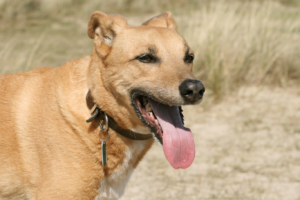Can Dogs Sense Stress in Humans?
They can sniff out cancer, COVID, corpses and the forgotten shrink-wrapped cheese stick in the bottom of your pack in the back of your closet. But can dogs smell stress? What about happiness? And what does that mean for the health of our furry family members—and for the dog-human relationship? Read on to find out, including the results of a recent study we found as intriguing as your dog may find a well-traveled sock.
What Can Your Dog Smell or Sense About Your Emotions?
Compared to our relatively useless snouts, dogs are super sniffers. Humans have 50 million olfactory receptors in our noses. Dogs have more than 220 million. Think that bacon smells good sizzling in the pan? Imagine if you could smell it, literally, millions of times better. It’s a wonder all dogs don’t melt into puddles of drool every time we make breakfast.
We’ve long known that dogs can sense human fear by smelling the chemicals we secrete when afraid and by reading micromovements of our bodies and face. And, most every pet parent can think of a time when a furry chin was planted on a lap or a gentle paw rested on a chest just when we needed it most. But science had not divulged any evidence regarding canine’s ability to smell stress in humans—until now. A new study published in the journal PLOS ONE[https://journals.plos.org/plosone/article?id=10.1371/journal.pone.0274143] suggests dogs can in fact, smell when humans are stressed.
From a larger group of wagging recruits, scientists at Queen’s University Belfast in the U.K. selected four dogs who, after initial testing, showed they were highly motivated to choose from different samples of human odors. The test crew consisted of Fingal, a male brindle rescue lurcher/hound mix; Soot, a female mixed-terrier type rescue; Treo a male Cocker spaniel and Winnie, a female cockapoo.
Their human counterparts were 36 nonsmokers who did not eat or drink anything before the test. Researchers collected sweat and breath samples from the human participants before and after they had to perform a difficult math problem. The researchers used samples from the subjects who showed signs of stress from the math—increases in blood pressure and heart rate. To collect the samples, gauze was wiped on the back of their necks and placed in a sterile glass vial. Then, they exhaled three times into the vial.
Separately, the researchers used clickers to train the dogs to recognize the stressed sample. For the test, they presented the dogs with three different scents, a standard piece of gauze, a sample from an unstressed human and a sample from a stressed human.
How’d they do? Fingal, Soot, Treo and Winnie correctly alerted the researchers to the stress samples in nearly 94 percent of the 720 trials.
“This study provides further evidence of the extraordinary capabilities of ‘man’s best friend,’ the study’s first author, animal psychologist Clara Wilson, told NBC News.“While it is likely that in a real-life context dogs are picking up on our stress from a variety of context cues, we have shown using a laboratory study that there is a confirmed odor component that is likely contributing to dogs’ ability to sense when we are stressed.”

What Emotions Can Dogs Sense?
Even without a single sniff, dogs have a remarkable ability to read our facial expressions and body cues. A study published in a 2018 issue of the journal Learning and Behavior found that dogs respond to human faces that express six basic emotions—anger, fear, happiness, sadness, surprise and disgust—with changes in their gaze and heart rate.
How Do Your Emotions Affect Your Dog?
It’s long been known that dogs pick up on human emotions. People who are afraid of dogs are commonly advised to approach dogs confidently, as “dogs can smell fear.” But is fear—and other emotions—contagious from person to pooch? Yes, according to research. In one study, Swedish researchers focused on the relationship between 58 dogs and their people, looking closely at their levels of cortisol—the hormone both species release when stressed. To do so they tested levels in strands of hair. They found that the dogs’ cortisol levels mirrored the levels of the humans who were experiencing long-term stress. They called it “emotional contagion.”
The researchers compared findings from pairs with dogs who competed in agility or obedience with dogs who did not. They found that the stress level of competing dogs seemed to be linked more strongly with the stress levels of their person. The researchers believe this might be because there is a higher degree of interaction between the pet parent and the dog when they train and compete together. Another study found that the extent of emotional contagion increases along with the time spent sharing the same environment.
In another study published in Animal Cognition, Italian researchers found that when dogs’ parents were happy—and smelled happy—dogs were more happy and inquisitive, especially around strangers. When pet parents smelled afraid, the dogs exhibited the same behavior and avoided strangers, sticking close to their humans. (How did the researchers instill fear—and happiness—in the pet parents so they could collect sweat samples? By having them watch “The Shining” and “The Jungle Book.”)
“The emotional connection between humans and dogs is the essence of the relationship,” Clive Wynne, a professor of psychology and director of the Canine Science Collaboratory at Arizona State University told National Geographic. “Dogs are amazingly social beings, so they are easily infected with our warmth and joy.” But that also means pet parents’ stress and anxiety can become our dogs’ stress and anxiety.

How to Keep Your Dog (And You) Emotionally Healthy
It’s no shocker that, after two years of a global pandemic and facing record inflation, Americans are feeling fried. Seventy-six percent of adults reported experiencing at least one health symptom in the last month as a result of stress, according to the American Psychological Association. Here are just a few things you can do to turn the stress dial down for you—and your pup.
- Hands On a Hound
Simply petting your pup releases oxytocin, the feel-good chemical sometimes called the “cuddle hormone.” It’s the same compound released in mothers and infants while breastfeeding to promote bonding. Research has also shown that petting a dog reduces our cortisol levels.
Enjoy quiet time petting your furry friend in their favorite spots or try your hand(s) at canine massage, which can offer additional physiological benefits to your pup. There are lots of how-to videos online, including this one from the American Animal Hospital Association.
Petting your dog cultivates your bond. And having that bond is, in itself, therapeutic to both of you. From an evolutionary standpoint, there’s the security of the pack. That social-for-survival instinct has brought people and dogs together in extended packs for at least 100,000 years. And while a five-pound chi-weenie might not necessarily fend off predators (or even the UPS guy), living in a pack still satisfies survival instincts in a way that can reduce stress.
When dogs and humans share emotions, it’s like social glue,” Marc Bekoff, professor emeritus of ecology and evolutionary biology at the University of Colorado, Boulder, and author of A Dog’s World: Imagining the Lives of Dogs in a World Without Humans, told National Geographic.
That social glue and bonding is critical to mental wellbeing.
- Go For a Romp
Whether you hit the trail for hours or simply get lost in a neighborhood sniff-ari, exercise is good for you and your furry partner. It lowers blood pressure, boosts endorphins that fight depression and anxiety and helps everything from brain health to sleep quality.
And if you exercise—or simply hang out—outside, the benefits are even greater. Scientists are unearthing more and more research about ecopsychology—how immersion in nature benefits your health. How long do you need to bask in the sun, or enjoy squirrel patrol, for it to make a difference in your mental, emotional and physical health? Exactly 120 minutes.
A study of 20,000 people found that people who spent two hours a week in green spaces either all at once or over several visits, were substantially more likely to report good health and psychological well-being than those who do not. Spend less than 2 hours? No dice, according to the study.
- Eat Well
You probably know that a well-balanced diet of high-quality, minimally processed foods helps all of our bodies’ systems function better. The same is true for your dog. Obviously, everyone’s happier when not constipated, gassy or bloated. But additionally, there’s a critical connection between our bellies and our emotions called the gut-brain axis.
The microbiome in the human and canine gut is home to hundreds and hundreds of species of microbes that help our bodies work best when they’re in balance. More than 80% of our immune systems reside in our gut. And, more than 70% of serotonin, the “happy hormone,” a key warrior in the battle against depression and anxiety, is made in the gut. The microbiome also creates GABA, another neurotransmitter that fights against depression and anxiety and dopamine, the “happy transmitter.”
FAQ
Our dogs’ amazing ability to sense our emotion is one of the (zillion) reasons we love them. It also kicks up a ton of questions. Here are answers to a few of the most common ones.
What do dogs do when they detect anxiety?
It depends on the dog. Like people, every pup is unique. Some are more sensitive to human anxiety than others. Some dogs may show increased signs of stress when their pet parent is anxious. The most common signs of stress in dogs include: panting, whining, drooling, shivering, aggression and pacing. Talk to your vet if your dog experiences acute or chronic signs of stress. He or she can help you identify and treat physical causes if they exist and recommend trainers who can teach you and your pup strategies for modifying behavior to ease anxiety.
Can dogs sense depression and anxiety?
Yes. They are incredibly adept at reading micro movements of our body—and smelling the compounds our bodies emit as our moods change.
Can dogs read facial expressions?
They sure can. They can even read emotions in photographs of faces. Dogs not only read our facial expressions, but it seems they also, in turn, communicate with us using their own facial expressions. Scientists at Portsmouth University’s Dog Cognition Centre in the United Kingdom found that dogs produced far more facial expressions when a human was watching than when no humans were looking at them.

Food + Emotional Health
While we pet parents know our pups can read our emotions, science has been yielding more and more fascinating research about exactly how they do it and how it may impact their, and our, mental, emotional and physical health. But don’t let the fact that you may share your stress with your innocent (well, except for the toast you left on the counter) furry friend keep you up at night. There are simple steps you can take to reduce stress for both of you.
PetPlate takes the stress out of nourishing your dog by delivering the best human grade, fresh-cooked entrees right to your door. No shopping. No measuring. No worrying. The meals are expertly formulated by a veterinary nutritionist to help keep your dog healthy—and happy. PetPlate uses information about your dog, including age, weight (and desired weight), activity level and breed, to create a special, customized plan for your dog, from Barkin’ Beef and Chompin’ Chicken to supportive meals like Power Packed Pork (high protein) and Lean & Mean Venison (low fat). Learn more here!.




